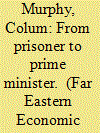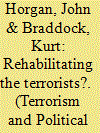|
|
|
Sort Order |
|
|
|
Items / Page
|
|
|
|
|
|
|
| Srl | Item |
| 1 |
ID:
091045


|
|
|
|
|
| Publication |
2009.
|
| Summary/Abstract |
Waiting to meet Bangladeshi Prime Minister Sheikh Hasina in her suite in a Manhattan hotel, I hear a baby's cries coming from the bedroom. Ms. Hasina, an aide tells me, is feeding her grand-daughter and will be with me shortly. Ms. Hasina enters the room dressed elegantly in a lime-green sari, and settles into an armchair. Behind her is a framed photograph of her father, Sheikh Mujibur Rahman, or "Father of the Nation," serving as a reminder of the bloody past of Ms. Hasina and of Bangladesh. The country's first prime minister after separation from what was then called West Pakistan, his wife and Ms. Hasina's three brothers were assassinated in 1975.
|
|
|
|
|
|
|
|
|
|
|
|
|
|
|
|
| 2 |
ID:
040812


|
|
|
|
|
| Publication |
New York, Macmillan Company, 1973.
|
| Description |
168p.hbk
|
|
|
|
|
|
|
|
|
|
|
|
Copies: C:1/I:0,R:0,Q:0
Circulation
| Accession# | Call# | Current Location | Status | Policy | Location |
| 012126 | 954.92/PAY 012126 | Main | On Shelf | General | |
|
|
|
|
| 3 |
ID:
139515


|
|
|
|
|
| Summary/Abstract |
A frigid Antarctic wind battered Rio Hondo throughout the night and into the next day. I awoke in the morning and could hear the windows being rattled by its gusts. Today was going to be a cold one. Thank heaven, the motel was warm.
|
|
|
|
|
|
|
|
|
|
|
|
|
|
|
|
| 4 |
ID:
151985


|
|
|
|
|
| Summary/Abstract |
TUCKED IN the borderland between Europe and Asia sits a nation-state recognized by seven American states, New South Wales, the Basque parliament, Abkhazia, Ossetia and Transnistria, but by no country—its chief financier and defender, Armenia, included. Six hours’ drive southeast of Yerevan, you reach it through a series of dry ochre canyons that give way to rolling green steppe. At the immense skyline of the Lesser Caucasus, you cross a passport control governing no official border and a time-zone change that goes unacknowledged. You drive up the most expensive strip of pavement in Transcaucasia, joining a winding trickle of minibuses and T-72 tanks chained to the beds of semitrucks. Between mountaintops stretch nets raised to ensnare attacking helicopters. Billboards claim that the crimes of 1915 may yet be avenged. A giant statue of a grandfather and grandmother hewn out of volcanic tufa is captioned with the motto of the republic: “We Are Our Mountains.” Descending into Stepanakert, the capital, you check in with authorities and observe the trappings of statehood—parliament, police force, postal system—developed over more than two decades of sitting within Grad rocket range of Azerbaijani forces, which make regular claims that they can capture Stepanakert in four days and threaten to shoot down any planes, commercial or military, that attempt to use its airport.
|
|
|
|
|
|
|
|
|
|
|
|
|
|
|
|
| 5 |
ID:
095296


|
|
|
|
|
| Publication |
2010.
|
| Summary/Abstract |
Renewed interest on how and why terrorism ends has emerged in parallel with increased visibility of some new and innovative approaches to counterterrorism. These are collectively known, whether for good or bad, as "de-radicalization programs." However, and despite their popularity, data surrounding even the most basic of facts about these programs remains limited. This article presents an overview of the results of a one-year pilot study of select de-radicalization programs and investigates critical issues surrounding assessment of their effectiveness and outcomes. We argue that Multi Attribute Utility Technology (MAUT) may offer promise for future empirical assessment of what we prefer to designate "terrorism risk reduction initiatives." Perhaps less obviously, and until more data surrounding the efficacy of such initiatives becomes available, MAUT may also provide a conceptual basis for planning, evaluating, and guiding the development of future such initiatives and may have the unanticipated consequence of facilitating progress by encouraging greater exploration of efforts to change behavior from other contexts.
|
|
|
|
|
|
|
|
|
|
|
|
|
|
|
|
|
|
|
|
|